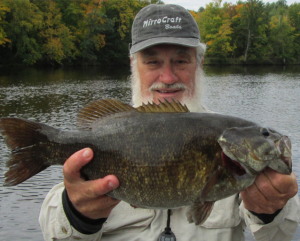Fishing Articles

The first tool to consider when hitting the water is
your choice of fishing rod. Fishing rods come in all lengths, quality levels
and prices. In the past, anglers had limited choices both in rod material and
rod style, with most people just looking at the price. Today, fishing rods range in price from $25
to $400 and while price is still often the deciding factor on the type of rod
an angler may purchase, today’s anglers have a much greater selection. However,
when buying a rod, keep in mind that you get what you pay for.
Years back when I started
guiding I had only one or two quality fishing rods. One time in early spring, I
was showing my client my new high-end fishing rod. His response was, “You don’t
need an expensive rod to catch fish, I’ve been using this rod for years and
have caught tons of fish.” The old timer’s rod looked as old as he was and the
rod guides were held on with duct tape. On that particular day my client had a
point. The smallmouth were hitting leeches as fast as they hit the water. There
was no need for casting distance or accuracy let alone a sensitive fishing
rod. A kid with a $10 rod and reel combo
could have caught as many fish as a pro.
Those days are now few and far
between and for every day like that, there are dozens of days when the angler
who had the right rod for the situation caught the most fish. Everyone knows
that you can’t use your ultra-light panfish rod to catch muskies, but when bass
fishing you can’t use the same rod when casting soft plastics and deep diving
crankbaits. You don’t need to have 20 rods in the boat but your success rate
will improve if you have the right tool for the job. On the other end of the
spectrum, a top of the line fishing rod probably won’t help a beginning angler.
You need to find the right balance to match your angling ability and
pocketbook.
The average angler will walk into
a bait shop or big box store with good intentions to purchase a new fishing
rod. He or she will pick up a rod from the rack and start shaking it
vigorously. They usually put the rod back in the rack, grab another one and
repeat the procedure several times. Eventually they will be down to two rods,
put one in each hand, shake them and choose the one that they think feels
right.
There is nothing wrong with
choosing a rod that feels right, but is it the right tool for the job? There is
a reason that rod manufacturers put ratings on the rod just before the handle
which rates the rods’ action and preferred line weight. There is consistent
scientific methodology that all rod manufacturers use to rate their rods, and,
for the most part, if anglers pay attention to the rod rating they can’t go
wrong.
The most critical factor when
choosing a rod is the rods’ action. Action is a measurement of deflection or
flex that the rod exhibits under load, and more importantly, where that flex
occurs along the rod blank. “Extra Fast” action rods flex more towards the tip.
“Slow” action rods distribute the flex progressively throughout the entire rod
blank.
The next thing to consider is the
rods’ power. Power is defined by the amount of pressure required to flex the
rod blank. Most rods are designed to optimally manage a specific range of lure
and line weights. The heavier the line and lure, the more power you’ll need to
cast, fight and pull effectively. The lighter the line and lure, the less power
you will need.
The measurement of the change in
the diameter of the rod blank from the tip to the butt is known as the taper.
Many use the term synonymously with the rods’ action. An aggressive taper at
the tip creates a faster action. A straight taper (one which changes at an
equal rate throughout the rod blank) creates a moderate or slower action.
At one time fiberglass was the
main rod component but todays rods are constructed of composite graphite.
Composite graphite rods are made with a blend of high-modulus graphite fibers
and are the backbone of the industry.
The higher the tensile strength of the fiber the stronger, more
sensitive the rod will be. This is also indicative of a high quality rod. High
quality rods require more man hours in their construction which contributes to
their higher price. Fishing rod
technology is increasing the strength and sensitivity of the modern fishing
rod.
Over the years I have worked with
a few rod manufacturers who make top quality rods. Many of these rods worked
fine for most applications but they needed a bit of tweaking. Since the perfect
rod was not available, the next step was to design rods made to my
specifications. With the help of my good friend Jim Grandt, who has been making
quality fishing rods for 30 years, and intense field testing, I am proud to
introduce my Smallmouth Plus Series rods.
Smallmouth Plus Series rods have blank through touch reel seat handle
construction which gives them performance beyond the competition. Sleek, low
frame design combines maximum sensitivity along with total control when
fighting a monster smallmouth. All Smallmouth Plus Series rods are constructed
using a 58 million modulus high strain graphite blank, the industry’s leading
technology.
The spinning rods have a short
fore-cork so you can put your finger on the blank for even more sensitivity.
The 13 inch handle adds three inches to the rod length from the end of the
fore-grip allowing for maximum balance when combined with a quality lightweight
reel. Durable construction utilizing Nitride plated stainless ultra-thin rings
set into marine grade stainless frames virtually eliminates cracks or ring
failure, creates less drag on the ring, insures unmatched ring performance and
produces great results with braided lines.
I presently have three rods
available for purchase. The first is a 6’6″ medium light action rod with a
fast tip for finesse presentations. This rod is ideal for fishing four to six
pound test fluorocarbon or monofilament line and fishing light jigs or
plastics. It is also a great rod for live bait applications and will also make
an excellent walleye rod.
My 6’6″ medium action rod is
designed for fishing soft plastics with eight to ten pound test line. If you
like to fish tubes, wacky worms and jerkbaits, this is the ideal rod. It can
also be used with small to mid-sized surface baits and crankbaits.
The 6’6″ casting rod is the
same blank as the spinning rod but is designed with features particularly well
suited for anglers who prefer a baitcasting rod.
I will be adding new application
specific rod models in the future, but am very excited about the three models
that are ready and available right now. Navigate your way to
Bigsmallmouthbass.com to see these hot new rods in action and to order what
will fast become your favorite rod.


Leave a Reply